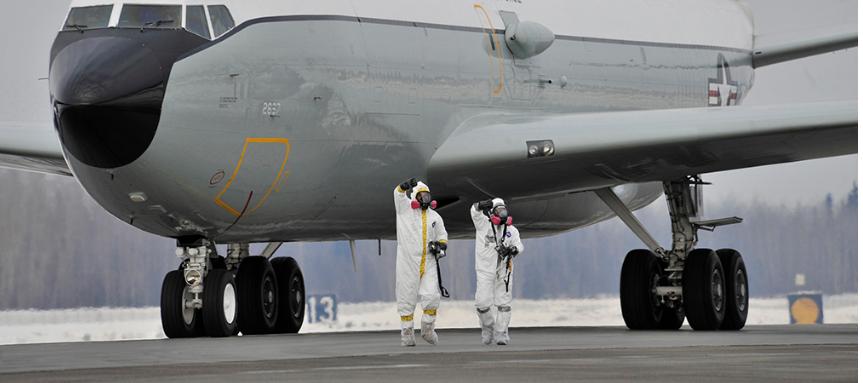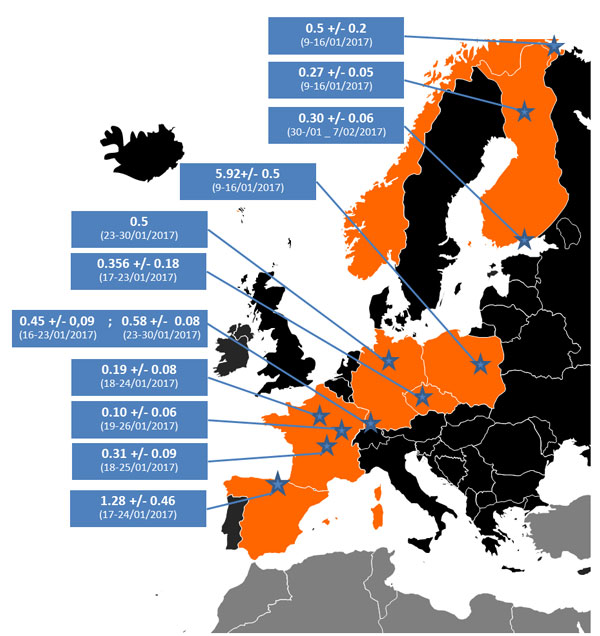Spike in radioactive Iodine-131 levels detected across Europe

A radionuclide of anthropogenic origin, Iodine-131, has recently been detected in tiny amounts in the ground-level atmosphere across Europe, IRSN, French public expert in nuclear and radiological risks, reports. Iodine-131 is a radionuclide with a short half-life (8 days), suggesting a rather recent release. So far, the source of the radiation remains a mystery.
According to the IRSN, the preliminary report states Iodine-131 was first found during week 2 of January 2017 in northern Norway but it was also detected in Finland, Poland, Czech Republic, Germany, France and Spain, until the end of January.
"Besides the iodine release, the origin of which is still unknown, the poor dispersion conditions due to the thermal stratification of the atmosphere also affected the observed concentration levels, including those of naturally occurring radionuclides such as Lead-210 (210Pb), or fine particles (PM2.5 and PM10) leading to pollution episodes, particularly in the Western part of Europe during week 4 of January," the institute said.
"It must be pointed out that only particulate iodine was reported. When detectable, gaseous iodine is usually dominant and can be estimated to be 3 to 5 times higher than the fraction of particulate iodine.
"In France, particulate Iodine-131 reached 0.31 µBq/m3 and thus the total (gaseous + particulate fractions) can be estimated at about 1.5 µBq/m3.
These levels raise no health concerns, IRSN said and added that the data has been shared between members of an informal European network called Ring of Five gathering organizations involved in the radiological surveillance of the atmosphere.

Credit: IRSN
Finland and France went public with information, but the isotope was first detected in Svanhovd, Norway.
While Norwegian authorities argue the measurements had no news value, the event was important enough for both Europe and the United States to deploy the U.S. Air Force WC-135 Constant Phoenix to RAF base in Mildenhall, England, UK.
WC-135 Constant Phoenix, also called the nuclear explosion sniffer, is a special purpose aircraft used to collect samples from the atmosphere for the purpose of detecting and identifying nuclear explosions and tracking radioactive activity.
Featured image: WC-135 Constant Phoenix. Credit: U.S. Air Force

The reference to the super-sized mosquitoes made me think about the ‘ancient’ giants. The mosquitos need blood for egg laying and I wonder if the red blood has anything to do with gigantism.
Yey France received particulate Iodine-131 reached 0.31 µBq/m3….wow super…. Poland received 5.9. Thx for caring.
Directly next to Ukraine – in its western neighbor – we had sore throats and lesser flu-like sicknesses, later it turned out that cancer occurrences were statistically higher after and probably heart failures too. Northern and NW parts of our country was inundated with the Chernobyl-Cocktail, mainly from rain: resulting in mystery sicknesses – heart & cancer mostly – in those territories and super large corn, large potatoes and other home grown garden vegetables and MONSTER MOSQUITOES. A normal mosquito is annoying enough: now think about 2x enlarged monsters those, of what you normally see and their bites resulted in large patched red-blue-brown painful injuries, almost like a serious spider bite.
Imagine if ~850kms away from the catastrophe these small effects could be witnessed after 26 April 1986, what hell could it have been right there at the site and surroundings….
I think in April-1986 , we had alert at Swedish nuclear plant sniffer detector giving info of Cesium134 & Cesium137 that was arriving from over Baltic sea. Chernobyl nuke blow up and made many nervous folks on my job. In Stockholm right away was a hike to obtain milk-powder in big sacks for ‘baby formula’ cause of the first wave scare. Elk hunting up north stopped then right away cause of nature loading with Cesium and others flying in with the jet stream. Some that read this shall perhaps remember this chapter of history.